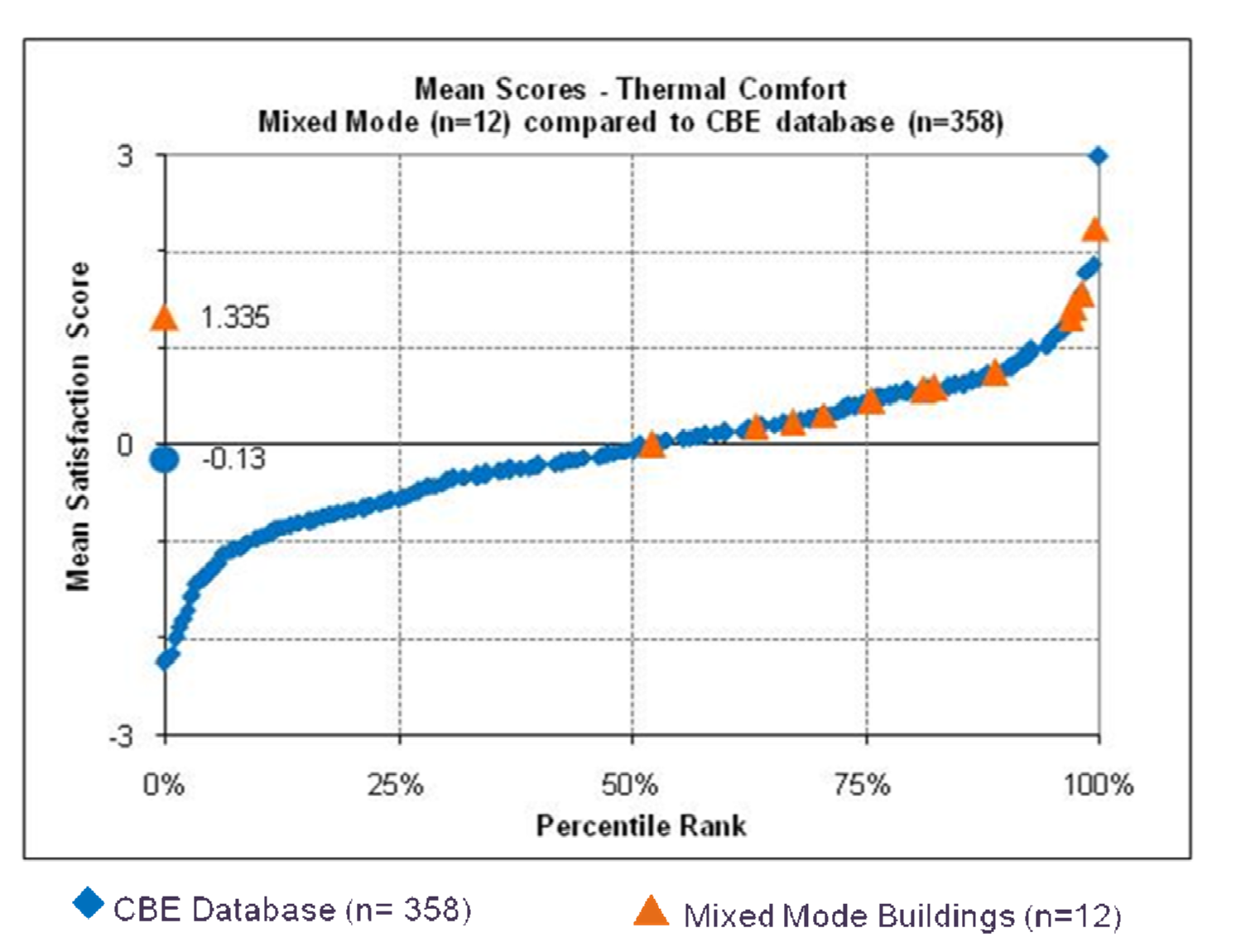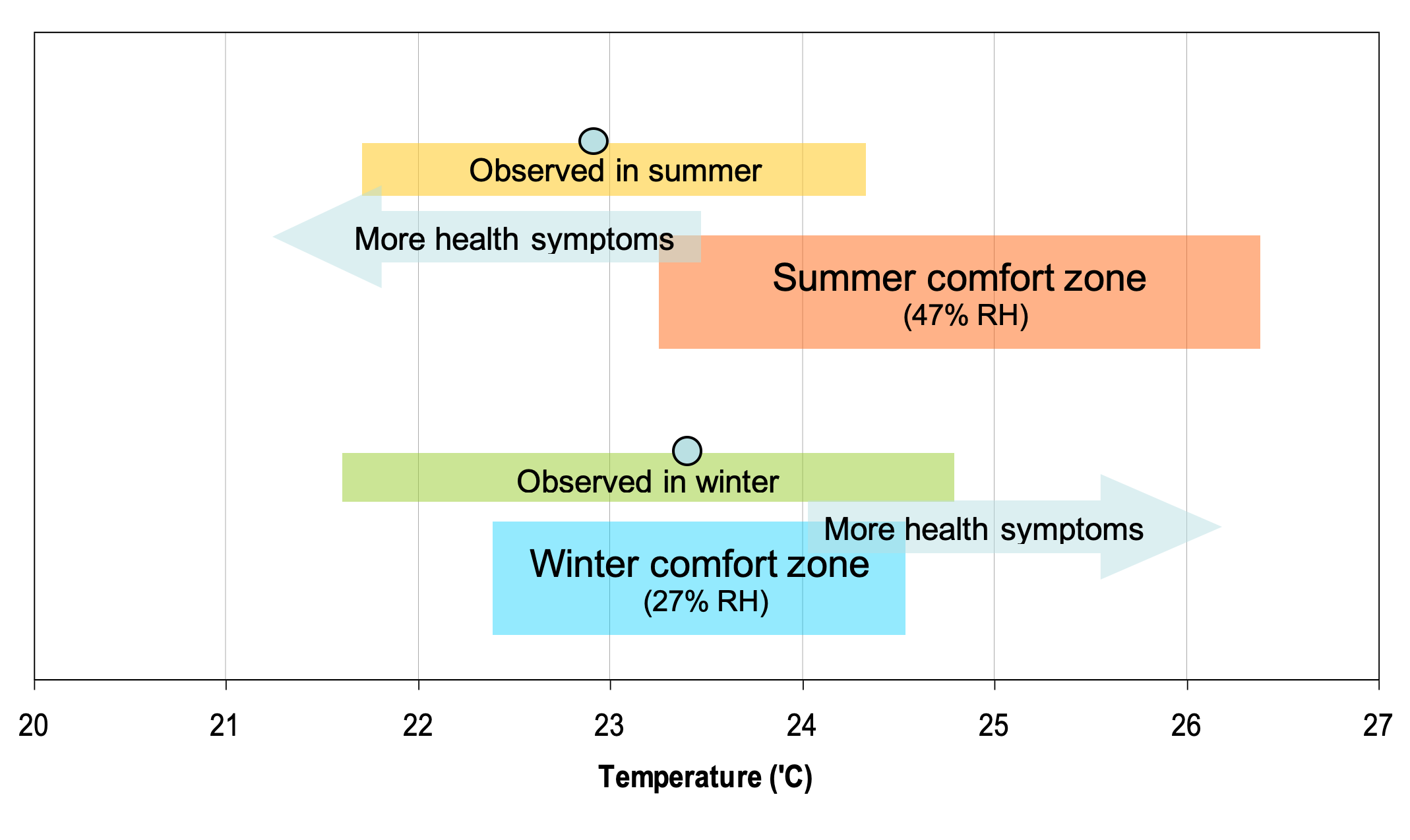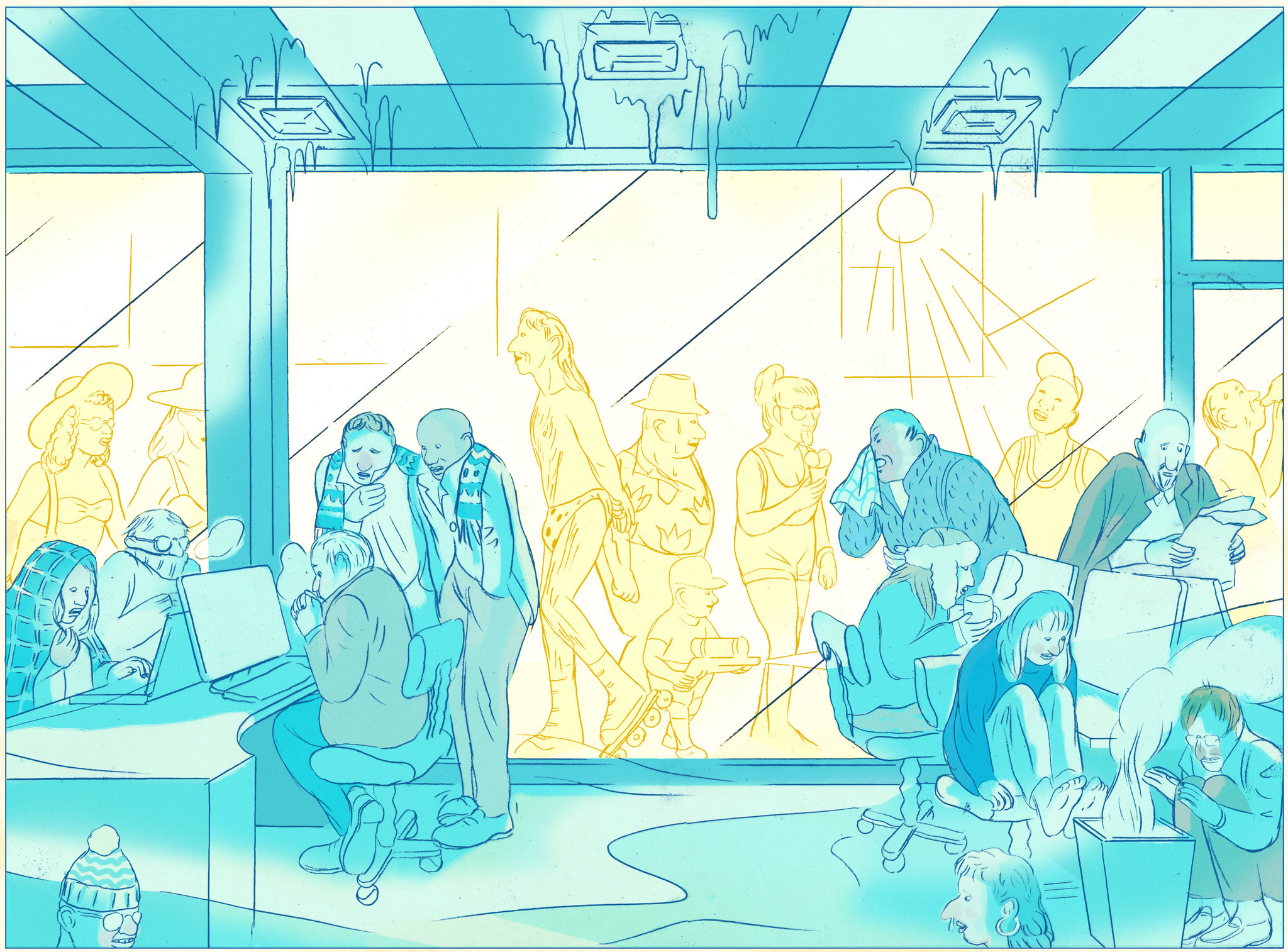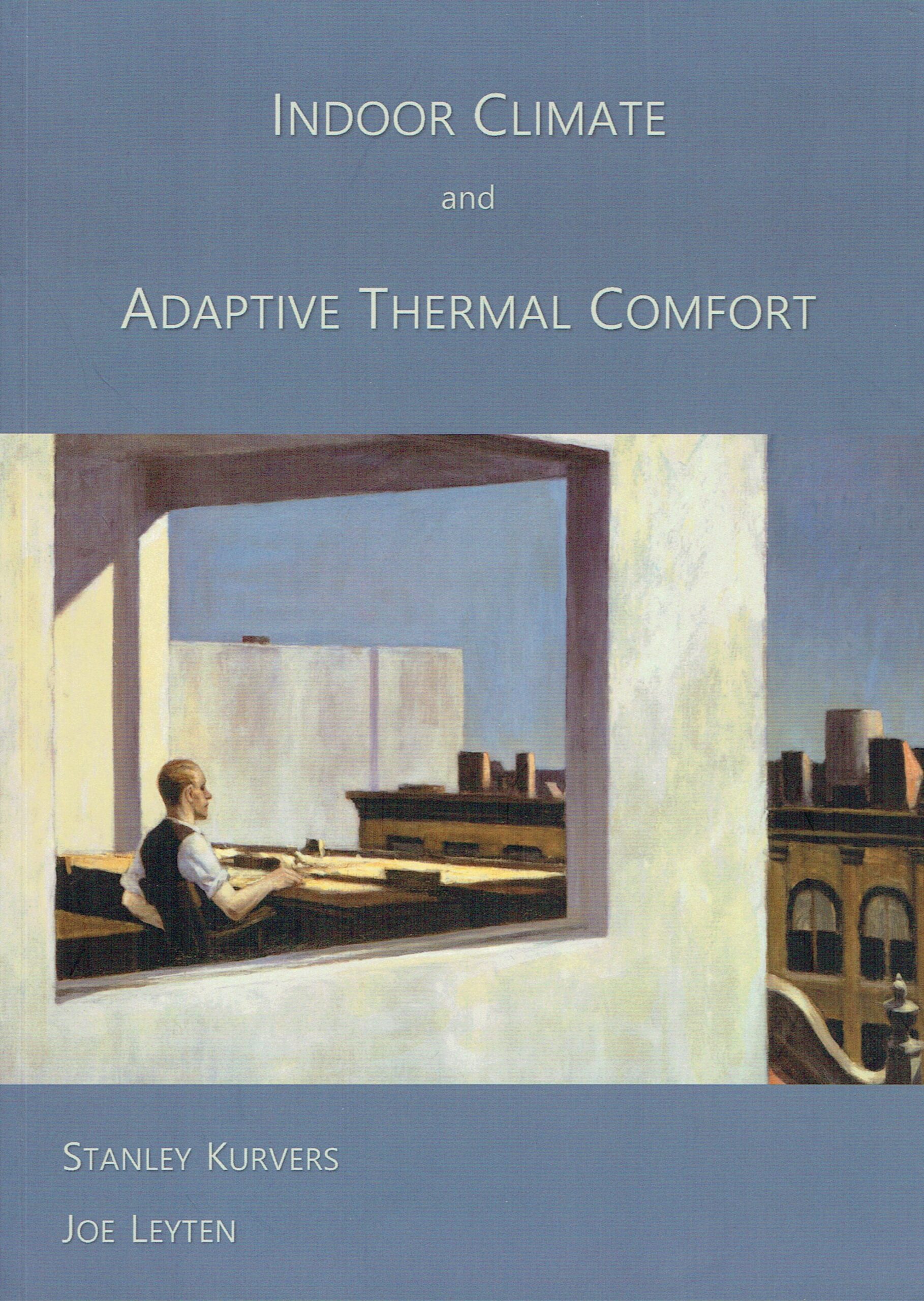1. The importance of a good indoor climate
In the course of history, man learned to design buildings in which extreme variations in the outdoor climate were taken into account in order to achieve a pleasant indoor climate. Many different, innovative building designs were developed with natural climate solutions adapted to the local climate. For example, by using heavy structures to buffer heat in the structure or by using open facades to let in cooling breezes. In other climates, wind catchers on buildings provide a cooling airflow inside, and air flows over tanks of water cause evaporation to cool the air. All with the aim of making the indoor climate more pleasant than the outdoor conditions, which can be extreme in some parts of the world.
From the end of the eighteenth century, knowledge in areas such as biology and physics increased and natural air-conditioning techniques were further perfected (Short, 2018). From the end of the nineteenth century, a revolution took place: technology developed very rapidly and advanced mechanical air-conditioning techniques emerged that could not only heat, but also cool, humidify and dehumidify air. Rooms could be kept at a specific temperature and humidity, largely independently of the external climate. Energy consumption was irrelevant because of the massive and cheap production of oil. At the beginning of the twentieth century, Willis Carrier developed a system to keep the temperature and humidity in a printing house within certain limits, which significantly reduced machine down-time and allowed more newspapers to be printed. A few years later, the first cinema in New York was equipped with air cooling, based on Carrier's invention. The number of visitors rose spectacularly and within a short time, hundreds of cinemas in the United States were equipped with air-conditioning. Subsequently, more and more department stores, offices, schools and even homes were air-conditioned. Air-conditioning developed into a global industry with huge marketing budgets that influenced consumers (Figure 1.1.


Figure 1.1: Examples of advertisements of the air conditioning industry around 1960 in the United States, where air conditioning was presented as a primary necessity of life. Source: www.pinterest.com/Vintage HVAC Ads.
The purpose of heating, ventilating and air conditioning (HVAC) systems is to support the building functions. The form, the structural characteristics, the building physics and the orientation determine, together with the prevailing outdoor climate and the indoor climate requirements, which systems are needed in a building. This means that for a given outdoor climate and comfort requirements, air conditioning becomes more important the less architectural and building physics properties are utilized. Examples of successful and specific applications are air conditioning in cars and trains, where building physics measures are not sufficient to bring the temperature to a comfortable and safe level. Also, in department stores, for example, which have a high internal heat load due to lighting, equipment and customers, or in microelectronics factories, where the manufacturing process requires narrow indoor climate tolerances, air conditioning can often be necessary.
Besides the many useful applications of air conditioning, there are downsides that have far-reaching consequences. The knowledge that architects have accumulated over the centuries to design naturally conditioned buildings has largely disappeared, because architects can now focus solely on “creating aesthetic forms” (Short, 2018). Necessary building physics principles and solutions were no longer integrated into designs, so that comfortable temperatures could only be achieved by energy-intensive air conditioning systems. Millions of people worldwide were thus made dependent on air conditioning (Lundgren-Kownacki, 2018). However, there is increasing evidence that air conditioning compromises the physiological adaptation mechanism in humans (Yu, 2012) and also impairs behavioral and psychological adaptation (Rijal et al., 2009). In addition to the huge implications for energy consumption, CO2 emissions and the contribution to climate change, there have been other consequences. Recent heat waves in the United States have caused more deaths than heat waves in previous decades. People often stayed indoors, relying on air conditioning, rather than using their evolutionarily evolved physical adaptability and behavior to cool off in the shade in parks, swimming areas and other natural cooling opportunities. The lack of useable openable windows meant that buildings could not be cooled at night by cooler outside air. The large peaks in energy demand led to power outages, air conditioning failures and consequently very high indoor temperatures, resulting in high mortality rates (Chappells & Shove, 2003; Lundgren-Kownacki, 2018).
In recent decades, much research has been conducted into how building users experience their indoor climate. In the periodic Benchmark of the Centre for People and Buildings, for example, which is based on 138 case studies in the Netherlands at 52 different organizations with over 23,000 respondents, measured in the period 2007 to 2016, 40% of the building users were dissatisfied with the indoor climate (CfPB, 2017). In an analysis of 351 buildings with over 52,000 occupants in the United States, 53% of the occupants appeared dissatisfied with the temperature. Buildings certified with a sustainability certificate or label for “health, productivity and liveability” (e.g., LEED, BREEAM, WELL) did not perform better than non-certified buildings in this analysis (Karmann, et al., 2018). An analysis of 11,243 responses from occupants of 93 LEED-certified office buildings in the U.S. and Canada found that no relationship existed between LEED rating and occupant satisfaction with the indoor environment (Altomonte et al., 2019). Among the reasons cited by the researchers are that personal influence has significant potential for increased comfort, improved energy performance, and increased satisfaction with the indoor environment, and that better metrics for achieving IEQ points are needed to form reliable indicators of user satisfaction.
A review article by Leyten (2006) describes research in 331 buildings in various countries in Europe and the United States. By means of measurements, technical building surveys and subjective responses of 31,500 employees, correlations were found between the comfort and health of employees on the one hand and the characteristics of the buildings on the other. Cooling, humidification and recirculation of the supply air, the absence of usable openable windows, insufficient possibilities to adjust temperature and ventilation by the occupants themselves and working in large open plan offices were risk factors for occupant dissatisfaction and health symptoms.
The risk factors are mainly found in buildings where the solar gain through the transparent façade is so high, that the indoor climate has to be controlled by means of air conditioning. As a result, the indoor climate is highly disconnected from the outdoor climate and the users have little influence on the temperature. In the American database of the Center for the Built Environment, with more than 370 buildings and 43,000 subjective responses from occupants about the indoor climate, the users gave their opinions about thermal comfort, air quality, lighting, acoustics and room layout, among other things (Brager & Baker, 2008). Only 11% of all buildings met the thermal comfort standard of at least 80% satisfaction. Mixed-mode buildings, which switch to cooling only when outside temperatures are high and featured operable windows, were then compared with the rest of the buildings (mostly with conventional air conditioning. Figure 1.2 shows that the occupants in mixed-mode buildings are on average more satisfied with the indoor thermal climate than those in air-conditioned buildings. This is largely due to the fact that the indoor climate is more variable and that occupants in this type of buildings have more opportunities to control the indoor climate.

Figure 1.2: The assessed mean satisfaction with thermal comfort per building, expressed on a 7-point scale (-3 = very dissatisfied to 3 = very satisfied) in the database of the Center for the Built Environment. Source: Brager & Baker, 2008.
In a study of 95 office buildings in the United States (Mendell, 2009), it was found that in summer the observed indoor temperatures were below the lower limit of the recommended summer range in ASHRAE Standard 55 in more than half of the cases. In winter, the recommended ranges were both under and over exceeded (Figure 1.3). Moreover, the mean indoor temperature was lower in summer than in winter. Since people are dressed more lightly in summer than in winter, this must lead to comfort problems, especially since such low temperatures are only possible in air-conditioned buildings and, as explained in Section 4.2, users of air-conditioned buildings are less inclined to adjust their clothing insulation. Furthermore, it was found that in summer, more health issues, such as headaches, fatigue and nose and throat symptoms occurred when the measured temperatures were lower than the comfort range. In winter, on the other hand, temperatures higher than the recommended upper limit led to more symptoms. Thus, more health symptoms occurred when there was too much cooling in summer and too much heating in winter. That this also leads to unnecessary energy consumption is obvious.

Figure 1.3: Measured temperatures and health symptoms related to the comfort intervals in ASHRAE-55 in summer and winter in 95 office buildings in the US. Source: After Mendell, 2009.
The question is why this official ASHRAE standard is often departed from in practice. A possible explanation for the low temperatures in summer is that it is a widespread view in the air-conditioning industry that employee performance is at its maximum at a temperature of around 22°C and that above and below that performance drops (Wargocki et al, 2006, 2007). Chapter 10 of this book explains that this view is incorrect (Parkinson, de Dear and Brager, 2020). However, it does not explain why higher temperatures occur in winter than in summer and even higher than the ASHRAE comfort range. A possible explanation for this is that maintaining extra-low temperatures in summer and extra-high temperatures in winter is seen by some companies, incorrectly, as a status symbol.
The human body needs to be kept at a core temperature of about 37°C as much as possible, and this is achieved to a large extent by autonomous physiological processes, such as vasoconstriction and vasodilatation to regulate the heat exchange with the environment, evaporating sweat when we are hot or shivering when we get cold. When we feel too cold or too hot, it is actually a warning sign of an eventual health threat.

Figure 1.4: Enduring Summer's Deep Freeze. Source: Olivier Schrauwen in Enduring Summer’s Deep Freeze by Kate Murphy, New York Times, July 5, 2015.
It is therefore an evolutionarily formed warning mechanism to ensure that we take measures to avoid (prolonged) discomfort. This adaptability has enabled humans to live in large parts of the world, in deserts (up to around +50°C) and around the North Pole (down to around -50°C). This sometimes requires very drastic measures regarding clothing and housing. It therefore seems paradoxical that precisely in buildings with full climate control occupants experience discomfort. Providing a thermally comfortable indoor climate does not mean that we must strive for a temperature level within a narrow bandwidth; on the contrary. Humans have a close relationship with nature and the climate due to their evolutionary adaptability. In winter, he or she expects a lower indoor temperature than in high summer, so he or she will put on warmer clothes. This expectation is based on experience of the relationship between outdoor and indoor temperatures. Variation in temperature can even give a feeling of pleasure. For example, when we are cold it can be very pleasant to sit temporarily in the sun, or near a stove that we would normally find much too hot (de Dear, 2011). In a warm environment, a cool breeze can be wonderful, while the same breeze can be irritating and uncomfortable when we are cold. This phenomenon is called alliesthesia and will be discussed further in Section 4.6. Variation in temperature also appears to be healthy for the heart and blood vessels and can help against obesity and diabetes (van Marken Lichtenbelt, 2017).
In 1948, the World Health Organisation (WHO) defined health as “a state of complete physical, mental and social well-being and not merely the absence of disease or infirmity”. With the invention of antibiotics, it was thought at the time that such a state could be achieved for everyone in the world. Now, more than 70 years later, far fewer people are indeed dying of all kinds of infectious diseases, but because we are getting much older, other chronic diseases have taken their place. According to the old definition, few people are healthy today. Therefore, after years of research and consultation, the WHO has proposed a new definition (Huber et al., 2011). It is not diseases, abnormalities or deficiencies that determine whether or not we are healthy, but the resilience and adaptability to take control of our lives as much as possible. The new concept is formulated as follows: “Health is the ability to adapt and self-manage, in the face of social, physical and emotional challenges” (Huber et al., 2016). The approach to thermal comfort as an adaptive process thus fits in well with the WHO's renewed view of health.
In recent decennia, medical science has been able to establish clearer links between regular high levels of physical activity and cardiovascular health (Stoops, 2004) and brain fitness (Scherder, 2017). Regular exercise is a critical factor for a healthy cardiovascular system. During exercise, a certain degree of discomfort is experienced, but after exercise, the production of endorphins provides a calm and satisfied feeling. The cardiovascular and thermoregulatory systems are closely related. During exercise, the released body heat is regulated by the thermoregulation system and the cardiovascular system is activated. There is agreement in medical science that the thermoregulatory system needs to be exercised for better health, as also shown in research on heat shock protein (Yu, et al., 2012, see Section 4.3). Many cultures have traditions of alternating hot and/or humid conditions with ice-cold immersion baths, such as the Greek and Roman baths, the sauna and the hammam in the Middle East. People have experienced these extreme temperature changes as pleasant and beneficial for centuries. In many buildings, however, we condition our interior spaces within narrow limits with the effect of exercising our thermoregulatory system as little as possible.
When a person gets cold, the body may start to shiver (this happens autonomously), which increases the metabolism and warms the person again. But even when you are a little cold, the body produces heat without shivering. The tissue that is responsible for heat production in these circumstances is brown fat. Regular exposure to cold increases the production of brown fat. In this way the body can adapt to cold conditions. What is initially experienced as uncomfortably cold becomes more acceptable over time (Van Marken Lichtenbelt, 2016). People who do not produce brown fat or have a relatively high amount of white fat appear to be less healthy. Brown fat also has a beneficial effect on the prevention of obesity. In type 2 diabetes, the hormone insulin has too little effect on the muscles, causing them to absorb too little sugar and too much sugar to enter the bloodstream. Medication is usually used to lower blood sugar levels. Research has shown that a regular stay in a cooler environment has a beneficial effect on the sugar absorption of muscles, so that medication can be reduced (Van Marken Lichtenbelt, 2017).
1.1 Definitions of building Types
In the foregoing, air-conditioned buildings and mixed mode buildings have already been mentioned, but in reality, there are various mixed forms of building and installation types. In the remainder of this book, when interpreting research on the differences in comfort experienced in different types of buildings, it is important to make a clear distinction between building types and how they are conditioned. This section will therefore first discuss the different building types.
In studies on adaptive thermal comfort, air-conditioned buildings refer to buildings with central air conditioning. The air is extracted at a central point, usually on the roof or top floor, filtered, heated, cooled, often humidified and sometimes dehumidified, and ducted through the building to the various rooms. Sometimes the air is recirculated to save energy, but nowadays part of the energy is recovered by passing the exhaust and supply air through a heat exchanger. In the (work)spaces, there are usually appliances in various shapes and designs for heating and cooling to control the temperature at the room level.
The indoor temperature is controlled using sensors, valves, pumps, motors and computer software. Many air-conditioned buildings have a layout with deep open plan work spaces. Sometimes there is a possibility for the users to control the temperatures per work space, but this possibility often proves ineffective in practice due to the size and depth of the work spaces and the presence of many people per workspace. Often there are also no or limited possibilities to open the windows, so adapting the environment to personal needs are limited. The indoor climate is largely decoupled from the outdoor climate, so that the indoor temperature does not or only marginally follows the outdoor temperature.
The term naturally ventilated buildings, or free running buildings, refers in the studies to buildings without mechanical (air) cooling in operation. The term naturally ventilated focuses on the supply of fresh outside air through openable windows, ventilation grilles in the facade or other structural facilities. The exhaust takes place by means of cross ventilation or passive or active central extraction. The windows can be operated effectively by the occupants to ventilate whenever needed and to influence the temperature, air movement and supply of fresh air. The term free running emphasises that there is no heating or cooling in operation at certain times of the day or year. The term climate-responsive is also sometimes used, which indicates that the building acts as a filter for the outdoor climate and a balance is established between excluding undesirable and admitting desirable climatic influences (Looman, 2017). The indoor temperature varies with the outdoor temperature and is controlled by building physics solutions such as shading, heat accumulation in the building mass combined with night ventilation. The emphasis is more on the application of (innovative) passive climate control techniques. In practice, these terms basically describe the same kind of building.
The term mixed-mode buildings is used in the literature in two ways: in the first major field study (de Dear, Brager & Cooper, 1997 hereafter RP-884 study) this term is used for fully air-conditioned buildings with windows that can be opened. These types of buildings were rare in this database. In this study, these buildings most closely resemble air-conditioned buildings. In a second large field study conducted in Europe (Nicol & McCartney, 2000, hereafter SCATs study) and in recent publications (Parkinson, de Dear & Brager, 2020), mixed-mode buildings are referred to as buildings that are free running for a large part of the time up to a certain temperature and are mechanically cooled to some extent above that temperature.
Mixed-mode ventilation is also referred to as hybrid ventilation, both natural and mechanical ventilation are used with the basic principle: natural if possible, mechanical if necessary. There is always a mode or circumstance in which natural ventilation is used. For the mechanical part, two variants can be distinguished. The first consists exclusively of a mechanical exhaust to create underpressure, whereby supply takes place via windows, grilles and specific openings. The second variant uses balanced ventilation, which may include filtering, heating, heat recovery, cooling and/or humidification (Van Bruggen, 2016). Most of the time, natural ventilation takes place and, above a certain temperature, mechanical ventilation, possibly with cooling of the supply air, comes into play.
When cooling is provided, hybrid ventilation most closely resembles buildings referred to in international publications as mixed-mode. Natural ventilation is always leading in hybrid buildings through the use of openable windows, dedicated ventilation openings and other provisions to achieve thermal draught (passive exhaust), supplemented by solutions for passive or free cooling, external shading, utilisation of thermal mass in combination with night ventilation and the use of modern control systems and sensors (TVVL, 2017). Most of the time, such buildings are free-running and below and above a certain indoor temperature, heating or cooling is provided. However, this must be done in such a way that through various forms of adaptation, thermal comfort can be achieved for and by the occupants (see chapter 4).
